FROM PAST TO PRESENT
Br-r-r-r-r-r
This post originally appeared November 7, 2009. Here’s an update with commentaries on how things have changed — and not changed — over the past 11 years.
Dateline: New Paltz, NY, October 19, 2009, 5:30 am. I bet my garden is colder than your garden. I was startled this morning to see the thermometer reading 23 degrees F. Not much I could do at that point about protecting “cold weather” vegetables still in the garden, some covered with floating row covers and some in “plein aire.” The thing to do under these circumstances was wait for the sun to slowly warm everything up and then assess the damage.
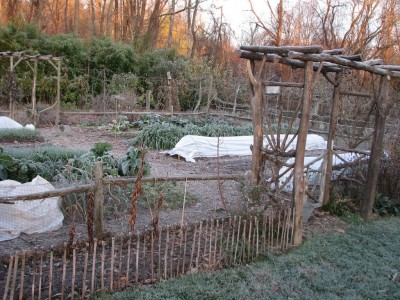
2009
I ventured out to the garden for a survey in the sunny midafternoon. Joy of joys. None of the cold-hardy vegetables was damaged by the cold. Romaine lettuces stood upright and crisp, arugula was dark green and tender, radishes were unfazed, and the bed of endive, escarole, and radicchio looked ready to face whatever cold the weeks ahead might offer.
That 23 degree temperature reading came from my digital thermometer, read indoors from a remote sensor out in the garden. Most surprising was the reading from the old-fashioned minimum/maximum registering mercury thermometer out in the garden. This thermometer remembered the night’s lowest temperature as 20 degrees F. Brrrrrrrr.
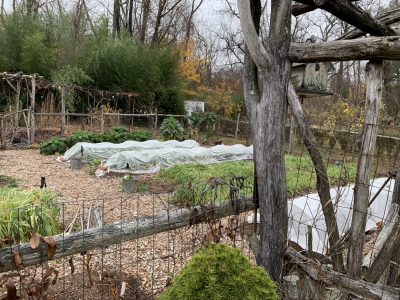
2020
Dateline: New Paltz, NY, November 11, 2020. This fall has likewise had a few frigid dips in the thermometer, down a couple of times to 24°F, and cold temperature vegetables have likewise fared well. Nowadays I check temperatures with a high-tech, but reasonably-priced, Sensorpush, a small sensor strategically hung in the garden. It beams current temperature and humidity back to my smartphone, and keeps a record of them throughout the day, week, month, and year. Its reporting jives with that of my “old-fashioned minimum/maximum registering mercury thermometer”.
What has changed is the weather over the past couple of weeks, with sunny days and temperatures hovering around 70°F. A fitting closing for a stellar year in the garden: best harvest, best fall color, congenial weather.
The effect of microclimate has been startling. I live about 4 miles out of town, on a road that follows the valley along the Wallkill River. On clear nights, radiation frosts spill cold air downhill to bring the temperature at the farmden about 5° colder than in town. A couple of evenings ago, temperature in town, as displayed on the local bank building and on my car thermometer as I drove through town, was 55°. Arriving at the farmden, the car thermometer, Sensorpush, and the “old-fashioned minimum/maximum registering mercury thermometer” registered 42° — quite a dramatic difference for a 40 foot elevation difference.
Mediterranean Fancies
(2009) Moving, figuratively, to warmer climes: the Mediterranean. I’m taking the Mediterranean diet one step further by trying to grow some of the delectable woody plants of that that region.
Figs are a big success, and not an unfamiliar sight well beyond their natural range. I’ve tried all the usual methods of growing them in cold climates. I’ve grown them in pots brought indoors for winter; I’ve bent over and covered or buried the stems to protect them from cold; I’ve swaddled the upright stems in leaves, straw, wood shavings, or other insulating materials. All yielded some fruit, but none of these methods beats having a small greenhouse with the trees planted right in the ground. Handfuls of soft figs, so ripe that each has a little tear in its “eye,” follow each sunny day and should do so for a few more weeks.
Bay (as in “bay leaf”) also does well, this one potted. After 20 years, my bay laurel is a

Bay laurel, 2009
handsome little tree, trained to a ball of leaves atop a single, four-foot trunk. The fresh leaves are much more flavorful, almost oily, than dried leaves, especially the old, dried leaves typically offered for sale.
(2020) Yes, figs have been abundant in the greenhouse over the past 11 years. But diminishing sunlight and cooler temperatures, even in the greenhouse (37° minimum temperature), have drained the flavor from the few ripe, remaining figs.
After 30 years, the bay is still thriving, valued as much for its beauty as for the flavor of its fresh leaves. It’s still trained as a small tree, smaller than in the past. I lopped the whole plant to the ground a few years ago to give it a fresh start, trained as round-headed tree only thirty inches tall.
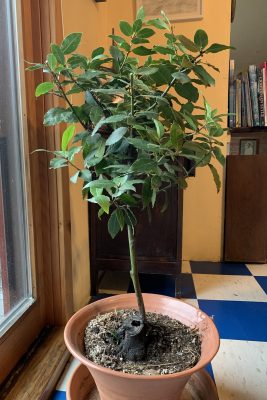
Bay Laurel 2020
(2009) Three hopeful Mediterranean transplants are my olive, feijoa, and lemons. I purchased the olive tree in spring, whereupon it flowered and has actually set a single fruit! The feijoa, also known as pineapple guava, has two fruits on it, which might not seem like a big thing except that those two fruits represent the culmination of about 15 years of effort. (More on that some other time.) True, feijoa is native to South America, but it thrives and is often planted in Mediterranean climates. The same goes for lemon, except that it is native to Asia. My Meyer lemon hybrid, like the olive, was potted up this past spring and sports a single fruit.
The long shots among my Mediterreans are pomegranates. My two plants – the varieties Kazake and Salavastki – are cold-hardy, early ripening, sweet varieties from central Asia, so should do well here in a pot. (They are cold-hardy for pomegranates, down to a few degrees below zero degrees F.) They have yet to flower and fruit.
In a few weeks I’ll move all the potted fruits to the sunny window in my very cool basement, where winter weather is very Mediterranean-esque.
(2020) All three trees are still residents here, although the feijoa tenuously so. It’s a pretty plant but what I really want from it is fruit. Yields have been paltry. I’ve repeatedly threatened it with the compost pile, but repeatedly reneged. Besides its beauty, it often flowers, and the flower petals, fleshy, pinapple-y, and minty, are delicious.
One year, in an effort to downsize plant-wise, I was also going to walk the olive to the compost pile. And then someone reminded me that the olive is a symbol of peace, so I kept it. It’s a pretty plant, an easy to care for houseplant, and occasionally bears tasty olives.
The Meyer lemon offers so much everything: deliciously fragrant flowers, verdant leaves year ‘round, and tasty lemons. Just not enough of them. Meyer lemon is actually a hybrid of lemon and sweet orange.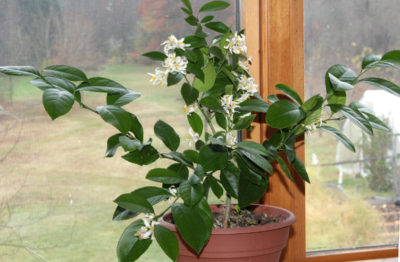
Pomegranate is still a long shot. I’m down to one plant, Salavastki. It often flowers and sets a few fruits, but the fruits drop off. I’m still not sure why.
Still Great After All Those Years
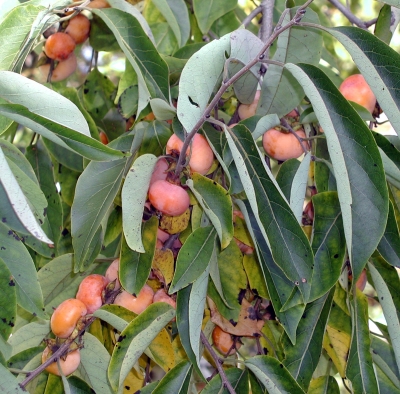
2009
(2009) Persimmon is another tree grown in Mediterranean countries, although it’s not native there. Up here, I grow American persimmon, an outdoor tree that is cold hardy to below minus 20 degrees F.. Besides yielding delectable fruits, it’s a tree that requires almost no care, not even pruning. Some of the tree’s branches are deciduous, naturally dropping in autumn.
Heavy winds of a few weeks ago took the persimmon’s self-pruning theme too far and blew the top off my 20 year old tree. Fortunately, my three other persimmon trees remained unscathed. I’ll just trim the break from the decapitated tree and it will be fine.
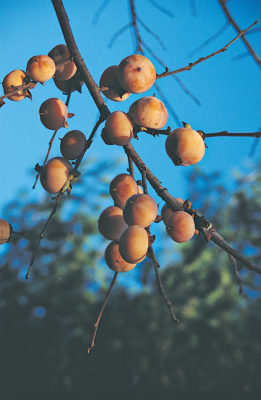
2020
(2020) Persimmon is still thriving, still care-free, and still delectable, the ripe fruits tasting like dried apricots that have been soaked in water, dipped in honey, and given a dash of spice. My persimmon “herd” has been thinned to my two best-tasting, most reliable varieties: Szukis and Mohler. Both are well-adapted to ripening in the the relatively short season (for a persimmon) this far north. Right now, the leafless tree is leafless and still loaded with fruit for the picking, much more than I can eat.

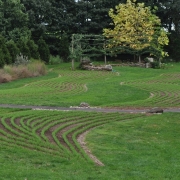


I’m curious how big the Szuki and Mohler get at your place.
I’m not sure, because I limit their height. Mohler drops its fruit, and beyond a certain height they wood splatter when the hit the ground. Szukis mostly has to be picked, and beyond a certain height I get scared. The trees’ heights are limited to 15 to 20 feet. I used to live in MD and know that, down there, the trees get quite large. They’d probably do so here also if permitted.
I have bay laurel that is about 3 years old and 20 inches tall. Leaves are growing all along the stem. I am wondering how to prune into a ball shape..there are no side shoots.
Enjoy your blog very much from here in Ottawa!
Linda
Cut back stems smaller than desired ball and then shorten the shoots that start growing to cause branching, and then branching of those resulting shoots, etc. I go into this in more detail in my book, The Pruning Book, which is available, signed if you wish, on the “books” page of my website.